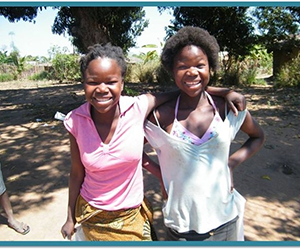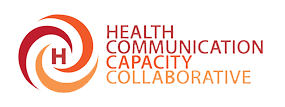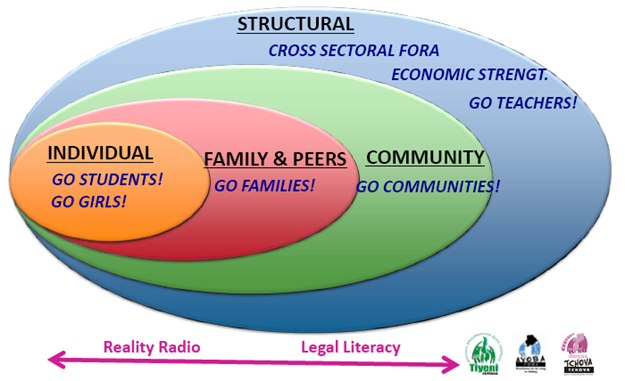Example: Understanding the Context of the Core Challenge

Two girls in Malawi attend a Go Girls! Project event. © 2011 Hilary Schwandt/CCP, Courtesy of Photoshare
Go Girls Initiative
In sub-Saharan Africa, girls are three to five times more likely to be infected with HIV than are boys of the same age. In response to this gender disparity, Go Girls! aimed to shift the focus from individual risk-taking to contextual factors that render girls vulnerable. The analysis stage concentrated on exploring these contextual factors. The results from the analysis informed the implementation of interventions at the various levels of the Social Ecological Framework. An important discovery was the fact that adults seemed aware that girls were vulnerable, but they didn’t feel they could do much about it. To address this, the initiative suggested ways to engender a community-wide response to girls’ increased risk of HIV infection. Findings of the analysis stage are outlined in the Research Findings Report.
Situation Analysis
Findings from a literature review augmented by qualitative research with community members in Botswana, Malawi and Mozambique guided the initiative’s understanding of factors that increase girls’ vulnerability to HIV infection. Formative research included focus groups to understand community perspectives on girls’ vulnerability; stakeholder meetings with government officials, community leaders and NGO/CBO representatives; and community mapping to identify resources and potential partners and to select project communities. Go Girls! combined quantitative and qualitative data collection methods to develop a deeper understanding of girls’ vulnerability.
Social Ecological Approach
Although individual sexual behaviors heighten adolescents’ risk, a complex interaction of social, legal and economic factors outside of girls’ control fuel the epidemic. The Go Girls! Initiative sought to address this constellation of factors by using a social ecological or “whole community” approach to preventing HIV. This approach recognizes that a girl’s ability to protect herself from HIV is influenced by a system of socio-cultural relationships— families, social networks, communities and nations. Thus, interventions were simultaneously implemented to reach out to communities, leaders, teachers and parents/guardians, as well as adolescents themselves. Though the focus was on girls, most interventions were also designed to include men, women and boys.
Using the Social-Ecological Framework, the Initiative focused on structural interventions as well as behavior and normative change and addressed contextual factors that present barriers to accessing education. Interventions included increasing girls’ resilience through building life-skills, strengthening parents’ ability to support girls, and supporting community dialogue and action.
The program components of Go Girls! thus addressed the barriers to structural, normative, social and behavior change and corresponded to the levels of the Social Ecological Framework: individual; family and peer networks; community; and society.
The program interventions were designed to achieve changes at the structural, community, family and individual levels.
Go Communities! – Community mobilization motivated community members to take action to reduce girls’ vulnerability to HIV.
Go Families! – Helped adults strengthen their communication skills and relationships with young people so they can talk to them about their needs and aspirations, as well as about sensitive topics such as HIV/AIDS prevention.
Go Girls! Community-Based Life Skills – Improved the knowledge and ability of vulnerable girls to address the specific factors that put them at risk of HIV.
Go Teachers! – Enabled teachers and school administrators to cultivate a safe school environment for students through the recognition of girls’ vulnerability in schools, gender equitable teaching practices and adherence to the teachers’ code of conduct.
Go Students! – Gave teachers the knowledge and know-how to facilitate life skills sessions for girls and boys that can help reduce their vulnerability to HIV/AIDS.
Economic Strengthening – Linked vulnerable girls and their families to existing economic support programs.
Cross-Sectoral Fora – Brought leaders from the communities and various government sectors together to garner support for Go Girls!
Reality Radio Programming – Used real-life stories to inspire community dialogue and action regarding girls’ vulnerability to HIV. Information about laws, regulations and enforcement was woven into every Go Girls! component to ensure these structural factors are addressed as part of the comprehensive approach.
The Go Girls! Initiative (2007-2011) was implemented in Botswana, Malawi and Mozambique by the Johns Hopkins Center for Communication Programs in partnership with Macro International, local nongovernmental organizations, community based organizations, and schools. The Initiative, with funding from the U.S. Agency for International Development through the U.S. President’s Emergency Plan for AIDS Relief, sought to reduce girls’ vulnerability to HIV transmission by strengthening gender programming and addressing the contextual factors that place adolescent girls at heightened HIV risk.


